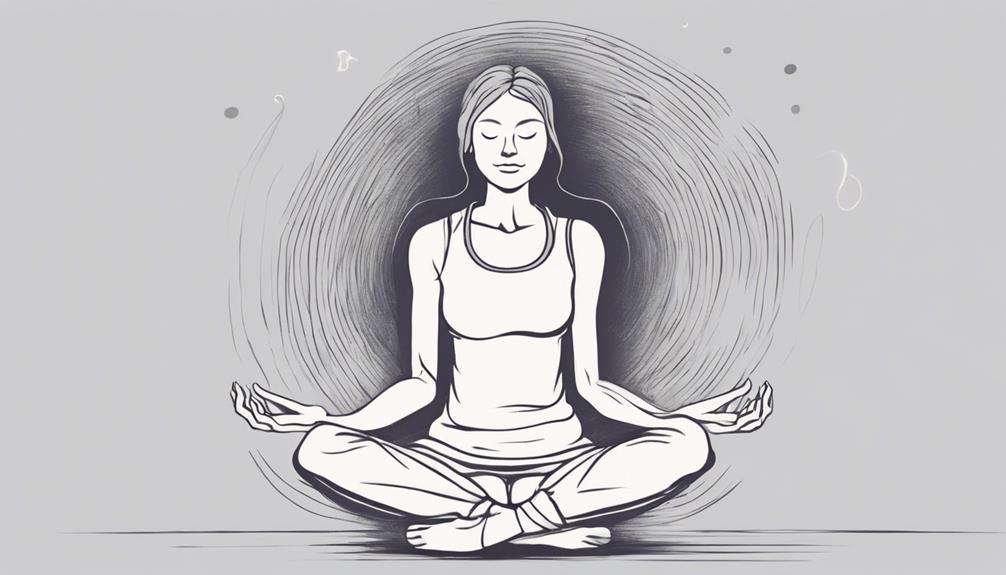When it comes to managing pain, sometimes the simplest methods are the most effective. By mastering the art of mindful breathing, you can unlock a world of relief and relaxation.
These 7 techniques offer a gateway to understanding your body's responses and harnessing the power of your breath to ease discomfort. Each method holds its unique benefits, waiting for you to explore and experience the transformative effects of mindful breathing.
Key Takeaways
- Mindful breathing reduces pain sensitivity naturally and aids in stress reduction for lower pain levels.
- Proper posture and alignment maximize lung expansion, crucial for deep breathing and pain relief.
- Deep breathing techniques activate the parasympathetic nervous system, lowering blood pressure and alleviating muscle tension.
- Mindful breathing modulates brain regions associated with pain perception, achieving deep relaxation and effective pain alleviation.
Benefits of Mindful Breathing for Pain Relief
By practicing mindful breathing, you can experience a significant reduction in pain sensitivity, offering a natural and effective way to manage various health conditions. Mindfulness meditation, a key component of mindful breathing, has been shown to help in stress reduction, which can contribute to lower pain levels. The breathing techniques involved in mindfulness meditation help modulate the somatosensory cortex, decreasing pain perception. Whether through traditional methods that focus on internal sensory details or virtual reality techniques that engage external stimuli, both approaches have been found to reduce pain sensitivity effectively.
Engaging in mindful breathing not only provides pain relief but also offers a holistic approach to improving overall well-being. By incorporating mindful breathing into your daily routine, you can tap into the power of your body's natural mechanisms to alleviate discomfort. This practice not only targets specific brain regions associated with pain but also has the potential to reduce reliance on medications for pain management. Embracing mindful breathing for pain relief opens up possibilities for extending these benefits to individuals with chronic pain conditions, promising a brighter future for managing pain more effectively.
Proper Posture for Mindful Breathing
For optimal benefits in mindful breathing, ensuring proper posture is essential to facilitate effective pain relief techniques. When practicing mindful breathing, maintaining a straight spine while sitting or standing allows for maximum lung expansion, aiding in deep breathing for pain management. Aligning your head and neck properly during breathing exercises can enhance oxygen intake and increase lung capacity, optimizing the pain-relieving effects.
Correct posture also supports the diaphragm's movement, enabling efficient deep breathing techniques crucial for pain relief. On the contrary, slouching or hunching can restrict the chest cavity, impeding the full inhalation and exhalation necessary for effective pain control through breathing. By adopting good posture habits during mindful breathing sessions, you promote relaxation, reduce muscle tension, and fully leverage the benefits of these techniques for managing pain.
Techniques for Deep Breathing

When exploring techniques for deep breathing, consider incorporating rhythmic breathing patterns to enhance relaxation and optimize oxygen intake for effective stress reduction and pain management. Deep breathing activates the parasympathetic nervous system, signaling your body to relax and reducing stress levels.
By focusing on deep, intentional breaths, you can lower your blood pressure and alleviate muscle tension, providing relief for both your body and mind. Proper deep breathing not only promotes relaxation but also aids in reducing chronic pain symptoms.
Consistent practice of deep breathing techniques can help in managing pain more effectively, offering a natural and accessible way to improve your overall well-being. By incorporating deep breathing into your daily routine, you can experience a reduction in stress, improved sleep quality, and a greater sense of calmness in both body and mind.
Start your journey to better pain management and stress reduction today by embracing the power of deep breathing.
Mindful Breathing for Relaxation
Explore the calming practice of mindful breathing to achieve deep relaxation and alleviate pain effectively. When you engage in mindful breathing, you're tapping into powerful brain mechanisms that can help relieve stress and promote relaxation.
Here's how mindful breathing works to achieve these benefits:
- Modulating Brain Regions: Mindful breathing influences specific brain regions associated with pain perception, helping to decrease the intensity of pain signals.
- Competing with Pain Signals: By focusing internally on your breath, you create a sensory competition within your brain, where the focus on breathing competes with external pain signals for attention and processing.
- Enhancing Blood Flow: Mindful breathing can lead to increased blood flow to areas of the brain involved in sensory processing, potentially reducing pain sensitivity and promoting a sense of calm.
Mindful Breathing for Muscle Tension

Mindful breathing gently eases muscle tension, fostering relaxation and relieving stress with each deliberate breath you take. When you engage in mindful breathing, you aren't only calming your mind but also allowing your muscles to relax. This deliberate act helps in reducing the physical strain that often accompanies stress and anxiety. By focusing on your breath, you can release the tightness in your muscles, promoting a sense of ease throughout your body.
Regular practice of mindful breathing can lead to a noticeable reduction in muscle tension over time. As you continue this practice, you may find that your overall well-being improves, and the discomfort associated with tense muscles diminishes. Mindful breathing is an effective tool in calming both your body and mind, which can have a positive impact on reducing muscle tightness and promoting relaxation. Embrace this technique to not only alleviate muscle tension but also to lower stress levels, ultimately contributing to your overall health and well-being.
Mindful Breathing for Headache Relief
To find relief from headaches through mindful breathing, start by creating a calm and focused environment where you can comfortably engage in deep breathing exercises. Mindful breathing can be a powerful tool in managing headache symptoms by promoting relaxation and reducing tension.
Here are some ways mindful breathing can help alleviate headaches:
- Improved Blood Circulation: Deep breathing techniques can enhance blood flow, potentially easing headache discomfort.
- Focused Breath for a Count: Practicing breathing exercises by focusing on counting breaths can help divert attention from the pain and calm the mind.
- Activation of the Somatosensory Cortex: Mindful breathing may stimulate the somatosensory cortex, contributing to pain relief and relaxation.
Mindful Breathing for Overall Wellness

Enhance your overall wellness through the transformative practice of mindful breathing, a technique proven to reduce stress and promote relaxation while positively impacting various aspects of your health.
To begin, find a comfortable position and take a moment to center yourself. Place one hand on your belly and the other on your chest. As you inhale deeply through your nose, feel your belly rise and expand, counting to four. Hold your breath for a count of two, and then exhale slowly through your mouth, letting go of any tension as your belly contracts.
Repeat this process several times, focusing on the sensation of your breath moving in and out of your body. This simple yet powerful practice can help modulate brain regions, decrease pain sensitivity, and improve your overall well-being.
Regularly incorporating mindful breathing into your routine can lead to a heightened sense of peace and an improved quality of life.
Frequently Asked Questions
What Breathing Technique Is Best for Pain?
When you seek pain relief through mindful breathing, consider deep breathing for relaxation, guided imagery for distraction, and diaphragmatic breathing for focus. Combining these techniques can offer comprehensive relief and promote overall well-being.
How to Use Mindfulness to Reduce Pain?
When reducing pain with mindfulness, focus on your breath. Use breathing exercises to calm your mind and body. Enhance the mind-body connection through mindfulness benefits for effective pain management. You can learn to ease discomfort.
How Do You Breathe Through Excruciating Pain?
When you breathe through excruciating pain, focus on deep breathing to calm your mind and body. Combine it with progressive relaxation, guided imagery, and visualization techniques for a holistic approach to manage and relieve pain effectively.
What Does the 4-7-8 Breathing Technique Do?
When you practice the 4-7-8 breathing technique, you tap into stress management and relaxation, improve sleep quality and reduce anxiety, enhance focus and concentration, and promote emotional regulation through mindfulness. It's a powerful tool.
Conclusion
As you practice mindful breathing techniques, remember that you're taking a powerful step towards managing your pain and improving your overall well-being.
Did you know that studies have shown that deep breathing can reduce pain perception by up to 36%?
By incorporating these techniques into your daily routine, you're giving yourself the gift of relaxation, stress reduction, and enhanced physical health.
Keep breathing mindfully and feel the benefits for yourself.






